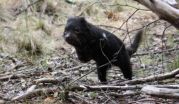Researchers shed new light on the genetic history of the European beaver
2014-02-18
(Press-News.org) An international team of scientists has used detailed analysis of ancient and modern DNA to show that the distribution and lack of genetic diversity among modern European beavers is due largely to human hunting.
The research, which was led by University of York researcher Professor Michi Hofreiter, provides important new insights into the genetic history of the Eurasian beaver Castor fiber. Crucially, it shows the European beaver has been strongly affected by expanding human populations for many thousands of years.
The researchers say that centuries of hunting, rather than changing climate conditions since the beginning of the Holocene (or recent) period, accounts for the lack of genetic diversity, as well as the geographic distribution of genetic diversity, seen in modern European beavers.
The research, which also involved researchers from Germany, USA, Norway, New Zealand, Russia, Poland, Sweden, Austria and the Netherlands, is reported in the journal Molecular Ecology.
Through DNA sequencing, the research team discovered that the Eurasian beaver can be divided into three distinct groups. The two main ones are in western and eastern Europe, with a now extinct, and previously unknown, third group in the Danube basin. This population existed at least 6,000 years ago but went extinct during the transition to modern times.
Professor Hofreiter, from York's Department of Biology and the University of Potsdam's Faculty of Mathematics and Life Sciences, said: "While beaver populations have been growing rapidly since the late 19th century when conservation efforts began, genetic diversity within modern beaver populations remains considerably reduced to what was present prior to the period of human hunting and habitat reduction.
"In addition, the rapid loss of diversity prior to conservation efforts appears to have established a very strong pattern for the geographic distribution of genetic diversity among present-day beaver populations."
Beavers have long been an important resource for human populations across the northern continents. Their fur is of exceptional quality, and has been a highly traded commodity. Beavers have also been hunted for meat and for castoreum - an anal gland secretion often used in traditional medicine. Stone engravings at Lake Onega in northern Europe indicate that beavers played a role in ancient human societies from around 3,000-4,000 years ago.
After centuries of human hunting, the Eurasian beaver had disappeared from most of its original range by the end of the 19th century, with only an estimated 1,200 beavers remaining.
The research team set out to discover whether the lack of genetic diversity and strong phylogeography (geographic distribution of genetic diversity) seen today are the result of its near extinction, or already existed prior to the reduction in its range. To do this, they examined DNA from 48 ancient beaver samples, ranging in age from several hundred to around 11,000 years old, and 152 modern DNA sequences.
The experimental work was carried out in Leipzig, Germany. Corresponding author Dr Susanne Horn, from the Max Planck Institute for Evolutionary Anthropology, Leipzig, said: "We found that overall there was more genetic diversity in the past. Apparently, already in ancient times an ancient contact zone existed between the eastern and western populations of beavers in the Oder River area. This is close to a present-day contact zone in Germany and Poland."
Professor Hofreiter added: "The present-day contact zone was assisted by conservation management and members of the eastern and western population groups meet there today as they did in the past. This suggests that conservation management may, in the long run, help to restore the pre-human impact population structure of threatened species."
INFORMATION:
The work was supported by the Max Planck Society and the Volkswagen Foundation.
ELSE PRESS RELEASES FROM THIS DATE:
Surprising survey: Most small businesses remain silent rather than report employee theft
2014-02-18
In a recent survey of small businesses, a University of Cincinnati criminal justice researcher has found that only 16 percent of those that have experienced theft by employees actually reported that theft to the police.
That's even though 64 percent of the small businesses surveyed reported experiencing employee theft.
These are some of the findings in a survey of small businesses that examined the incidence of employee theft, how often it was reported, the types of goods taken by employees, the types of employees most likely to commit theft, and the reasons the business ...
Einstein's conversion from a static to an expanding universe
2014-02-18
Until 1931, physicist Albert Einstein believed that the universe was static. An urban legend attributes this change of perspective to when American astronomer Edwin Hubble showed Einstein his observations of redshift in the light emitted by far away nebulae—today known as galaxies. But the reality is more complex. The change in Einstein's viewpoint, in fact, resulted from a tortuous thought process. Now, in an article published in EPJ H, Harry Nussbaumer from the Institute of Astronomy at ETH Zurich, Switzerland, explains how Einstein changed his mind following many encounters ...
Daily walk of just 3km can reduce risk of hospitalization for respiratory problems
2014-02-18
New research in Respirology shows that suffers of Chronic obstructive pulmonary disease (COPD) can reduce their risk of being hospitalized with severe attacks, by maintaining an exercise regime of walking between three to six kilometers a day.
COPD, a term which includes chronic bronchitis and emphysema, results in breathing difficulties due to long-term lung damage. Severe symptoms (eCOPD), caused by a sudden loss of lung function, can be life threatening.
543 COPD patients were recruited from five Spanish respiratory clinics and their exercise levels were calculated ...
Magnesium may protect against hip fractures
2014-02-18
Drinking water with a relatively high concentration of magnesium protects against hip fractures, according to results of a study from the Norwegian Institute of Public Health.
There are considerable variations in the quality of drinking water in Norway. The researchers studied variations in magnesium and calcium levels in drinking water between different areas, as these are assumed to have a role in the development of bone strength. They wanted to examine whether there was a correlation between magnesium and calcium concentrations in drinking water and the incidence ...
Beauty & bacteria: Slim, attractive men have less nasal bacteria than heavy men
2014-02-18
Do attractive traits tell us anything about a person's reproductive health? New research in the American Journal of Human Biology reveals a link between Body Mass Index (BMI) and the amount of bacteria colonizing noses. The results show that heavier men harbor more potentially pathogenic species of bacteria in their nose, compared with slimmer, more traditionally attractive men.
"According to an evolutionary point of view, traits related to attractiveness are supposed to be honest signals of biological quality," said Dr. Boguslaw Pawlowski. "We analyzed whether nasal ...
Malnutrition decreases effectiveness of HIV treatment in pregnant African women
2014-02-18
In Uganda the prescription of three antiretroviral (ARV) drugs, which aim to suppress the virus to prevent disease progression, have resulted in huge reductions in HIV mortality rates. However, disease is not the only scourge in Uganda, and a new study in The Journal of Clinical Pharmacology explores the impact food insecurity may have on treating pregnant women.
A U.S-Ugandan research team explored the affect pregnancy and malnutrition can have on the administration of lopinavir/ritonavir (LPV/r) and efavirenz (EFV) drugs among HIV-infected women in Tororo, Uganda.
Blood ...
Infected Tasmanian devils reveal how cancer cells evolve in response to humans
2014-02-18
Tasmanian Devil Facial Tumour Disease (DFTD) has ravaged the world's largest carnivorous marsupial since it emerged in 1996, resulting in a population decline of over 90%. Conservation work to defeat the disease has including removing infected individuals from the population and new research in Evolutionary Applications explains how this gives us a unique opportunity to understand how human selection alters the evolution of cancerous cells.
DFTD is an asexually reproducing clonal cell line, which during the last 16 years has been exposed to negative effects as infected ...
Computer arranges pictures based on their artistic aspects
2014-02-18
This news release is available in German.
Until now, it has been a time-consuming process for a program to arrange pictures in a consistent order. It is even more complex to order them on the basis of visual characteristics. Computer scientists from Saarbrücken have developed a system to arrange pictures into a consistent order. It requires no more than a small number of pre-sorted example pictures. Operators of online portals or museums could use this technique, for example, to arrange complex datasets.
So far, if a nature photographer wanted to arrange pictures ...
Scientists chip away at the mystery of what lives in our mouths
2014-02-18
COLUMBUS, Ohio – Scientists have pieced together sections of DNA from 12 individual cells to sequence the genome of a bacterium known to live in healthy human mouths.
With this new data about a part of the body considered "biological dark matter," the researchers were able to reinforce a theory that genes in a closely related bacterium could be culprits in its ability to cause severe gum disease.
Why the dark matter reference? More than 60 percent of bacteria in the human mouth refuse to grow in a laboratory dish, meaning they have never been classified, named or studied. ...
ASU professor explores the ethics of scientific research and why they matter
2014-02-18
CHICAGO — Discovery and innovation are important to science, but how are they connected to each other, and how can they be fostered to benefit the wider public? Jason Robert, the Lincoln Chair in Ethics and Dean's Distinguished Professor of Life Sciences at Arizona State University discussed that question today (Feb. 16) at the annual meeting of the American Association for the Advancement of Science in Chicago.
"While most of the people at the AAAS meeting are presenting their research results, we're asking scientists to think harder about what they're doing in their ...

